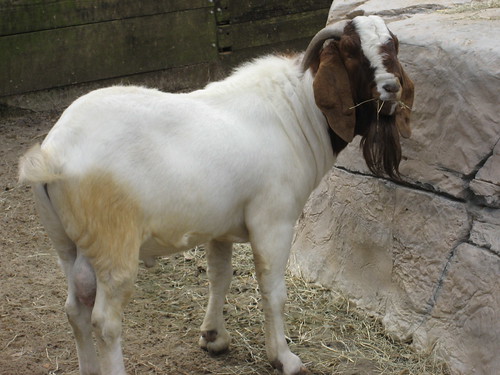My neighborhood gets pretty festive for Christmas, but I find the amount of time and money that goes into Halloween is staggering. Fun, but a bit crazy.
I love Halloween and, admittedly, I require vigilant adult supervision in the Halloween aisles so that I don’t cart home every single novelty item pertaining to bones or mummies. Fortunately, I hate clutter so I’m generally able to resist all but the very coolest items.
Up until about 1984, folklorists considered Halloween the least commercial modern holiday.
Now, like an undead neoliberal dream, the American fear of strangers shambles forth anew each year to pick pockets and fill attics with orange & black plastic rubbermaid tubs packed with tombstones, black and orange tinsel, light strings, spiderwebs, fog machines, and decapitated rubber body parts. (As of 2006, Snopes reported that Halloween was still down in 6th place in terms of total holiday retail spending, but that doesn’t negate the fact that it’s a multi-billion-dollar holiday).
But let’s get to the candy-tampering legends, since that’s the actual topic of this post and the most likely factor for this orgy of Capitalism.
In 1970, the New York Times ran a lengthy article about Halloween sadism, extensively quoting an ultra-conservative psychiatrist named Reginald Steen, who spun an elaborate tale of potential sadism and candy tampering by people emboldened by what he considered the increasing over-permissiveness of modern society.
In 1975, Newsweek reported the unsubstantiated “fact” that several children had died and hundreds more had barely escaped injury from candy tampering by strangers.
They were almost sort of accurate, in that a child did die from eating poisoned candy. In Death Makes a Holiday: A Cultural History of Halloween, David Skal describes the 1974 murder of a young boy. Ronald O’Bryan put cyanide in pixie sticks, killed his young son, and collected the insurance money. At first he was a hero because he leapt into action and saved the other neighborhood children from eating the tainted candy. Which he had poisoned.
Dubbed the Candyman by the press, O’Bryan was tried and convicted in 1975.
The National Confectioners Association worked desperately with the FDA throughout the 70s and 80s to debunk this story but were unsuccessful. Candy manufacturers were unable to avoid a changeover to individually wrapped candy, which is more expensive to produce. Additionally, the emphasis on “safe” costumes” and decorations for group celebrations encourages people to spend more money on decorations, less money on candy.
Ironically, baking Halloween-themed treats (after purchasing the specially decorated cupcake supplies or cookie cutters or black icing) is wildly popular now. It seems like it would be a lot easier to poison a batch of cookies than to concoct a nefarious terrorist plot involving individually wrapped candy. After September 11th, there was apparently an upswing in parental fears about anthrax on candy –
Or to conceal a razorblade in an apple, an action that any sane person who’s ever seen an apple realizes is pretty much impossible. That’s not to say that no one has ever tried it (I can’t prove it didn’t happen) or that kids don’t attempt it for attention, concealing the damage to the apple’s skin by claiming they bit into it, but I just want to point out that it’s a pretty ridiculous idea.
In 1985, California State University sociologist Joel Best collaborated with folklorists to study these legends of anonymous Halloween sadists.
In “Razor Blade in the Apple,” (Social Problems, 32(5):488-499), Best reports they found a lot of localized hoaxes between 1959-1985, and some attention-seeking behavior from kids, but no evidence of strangers tampering with candy.
At a time when evangelical ministers were becoming regular cultural commentators on television talk shows, satanic and ritualized abuse panics were reported breathlessly on the nightly news, and people were growing concerned that increasing urbanization would lead to isolation and the breakdown of communities, Best concluded that protecting the children from this amorphous threat with a bold gesture once a year was a way to express fears about social change without taking radical action or working for real change in society.
According to Skal, the 1982 Tylenol poisonings in Chicago caused a temporary upswing in paranoia in the National media that had consequences for the way many products are packaged, but had surprisingly little lasting impact on Halloween.
Best agrees with Urban Legends and Folklore guru Jan Harold Brunvand that legends like this persist because they have a very general underlying message that can evolve as social conditions change. He concluded that the national media played very little role in keeping the legend alive. Local communities acted out their fears in their own ways.
Just yesterday, not wanting to let facts get in the way of a click-bait story about a possible case of candy-tampering, ABC news published a story that included this:
The story concludes with this information:
Last year the NCA shut the hotline because “there is very little occurrence of tampering,” said spokeswoman Susan Smith. “Tampering is extremely rare, and we don’t even track it anymore because police just aren’t seeing it,” she said.
Oh, hey, look! (listen?) you can listen to NPR’s Robert Siegel interview Greg Best about candy tampering
updated to add this article I missed on the Smithsonian Magazine blog: Where Did the Fear of Poisoned Halloween Candy Come From?
I wanted to write a really great conclusion to this post, but now all I can think about is making grilled cheese bats, so instead here’s the trailer for a fun Halloween movie, Trick-r-Treat:



